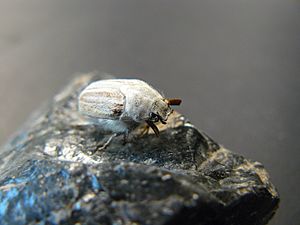Casey's June beetle facts for kids
Quick facts for kids Casey's June beetle |
|
|---|---|
 |
|
| Conservation status | |
| Scientific classification | |
| Genus: |
Dinacoma
|
| Species: |
caseyi
|
The Casey's June beetle, known scientifically as Dinacoma caseyi, is a type of beetle belonging to the scarab family (Scarabaeidae). This special beetle is listed as an endangered species. About 587 acres (237 hectares) of land in Riverside County, California, are set aside as important habitat for its survival.
About the Casey's June Beetle
Experts say that Dinacoma caseyi is a unique species. It has its own special group, called the caseyi complex, which is different from other beetles in the Dinacoma genus.
This beetle was first found in Palm Springs, California, in 1916. It was officially described in 1930 by a scientist named Blaisdell, who studied male beetles. Casey's June beetles are about 0.55 to 0.71 inches (1.4 to 1.8 centimeters) long. They are usually dusty brown or whitish. Their wing covers (called elytra) have brown and cream stripes running lengthwise.
Life of the Casey's June Beetle
Scientists have studied Casey's June beetles to learn about their lives. Both male and female beetles come out of their underground burrows between late March and early June. They are most active in April and May.
Female beetles are always seen on the ground and cannot fly. They look quite different from the males, with a larger body and smaller legs and antennae. These features help them live underground.
Male beetles fly around near sunset during their active season. They often fly back and forth or crawl on the ground where a female beetle has been found. It's thought that females stay on the ground and release special scents (called pheromones) to attract flying males.
After mating, the females go back into their burrows or dig new ones to lay their eggs. When scientists dug up burrows, they found old pupal casings (like cocoons) about 4 to 6 inches (10 to 16 cm) deep.
The young beetles, called larvae or grubs, likely spend about a year underground. We don't know exactly what Casey's June beetle larvae eat while they are underground. However, other types of June beetle larvae eat plant roots or decaying plant material. It's believed that Casey's June beetle larvae eat any organic matter they find in their sandy habitat.
Scientists haven't found any specific plants that Casey's June beetles prefer. Even though many burrows have been found near woody shrubs in Palm Canyon Wash, this might be because these areas are less disturbed by cars, people, or horses.
![]() This article incorporates public domain material from the United States Fish and Wildlife Service document "Endangered and Threatened Wildlife and Plants; 12-Month Finding on a Petition To List the Casey’s June Beetle (Dinacoma caseyi) as Endangered With Critical Habitat".
This article incorporates public domain material from the United States Fish and Wildlife Service document "Endangered and Threatened Wildlife and Plants; 12-Month Finding on a Petition To List the Casey’s June Beetle (Dinacoma caseyi) as Endangered With Critical Habitat".


